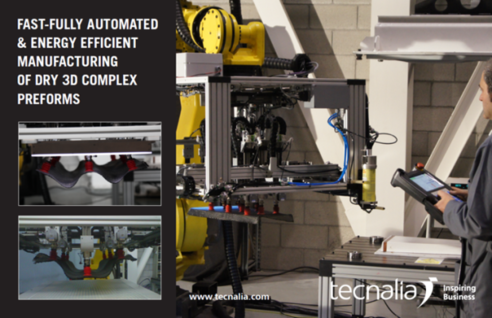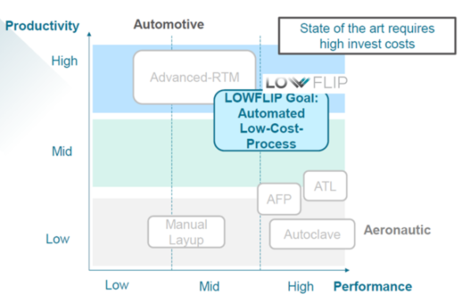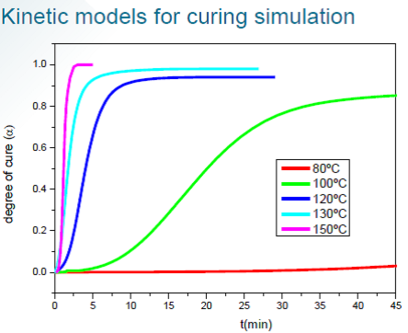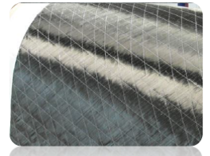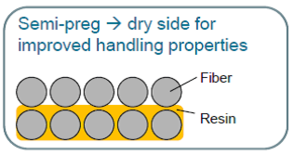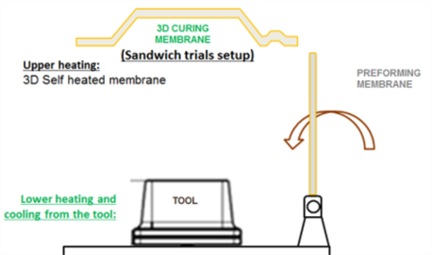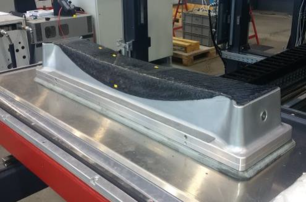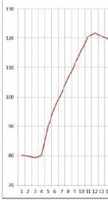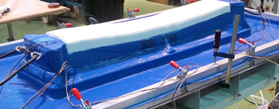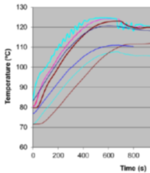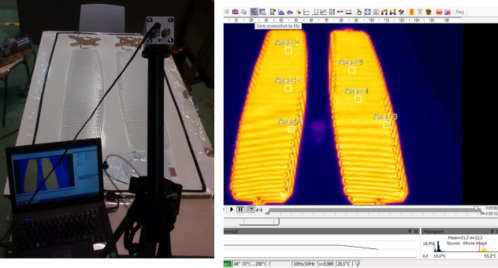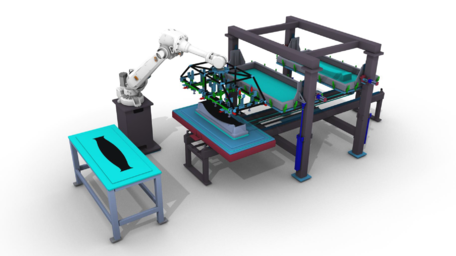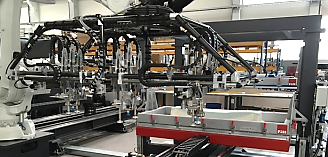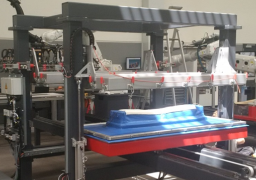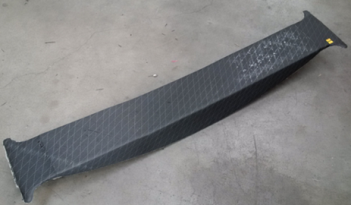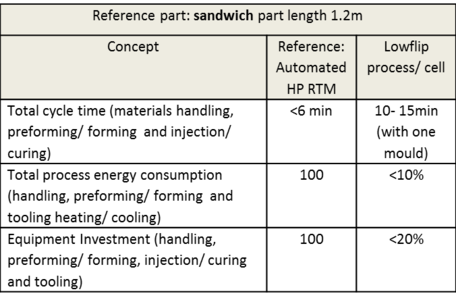1 Introduction
The cost structure involved in the manufacture of an advanced composite part is dominated by process costs that can reach up to 70% of the overall cost in some cases. This factor also limits the production capacity for some mass production applications. In this context, Tecnalia has developed a new flexible and fully automated cell called “Tecnacomp” (Figure 1) for the manufacture of small/medium-size 3D dry preforms. The process approach consists of a pick & drape & place unit mounted on a robot, and then combined with fast and flexible heating and compaction solutions.
Figure 1- “Tecnacomp” automated cell developed by TECNALIA.
This process concept originally developed by Tecnalia for dry fiber preforms, during the LOWFLIP project, has been validated also for fast curing prepregs by Tecnalia and has been then scaled up by the partner FILL to be able to adress bigger parts and with appropriate equipment at industrial level.
The project LOWFLIP aimed at developing new technologies in many different areas along the process chain of fiber reinforced polymers with the goal to set up automated production processes which require significantly lower invest than comparable state-of-the-art technologies (see Figure 2).
Figure 2- Comparison of LOWFLIP approach with state of the art processing technologies.
2 Snap curing prepreg material development and characterization
The development of a tailored resin formulation for the novel prepreg materials was a crucial point. A new resin system has been developed by SGL and tested during the project, featuring out-of-autoclave snap-cure capabilities and the following properties :
- ong shelf-life at room temperature: ≥28 days
- Glass transition temperature of 120 °C
- Suitable for out-of-autoclave curing
- Tailored tack for automated processing
Figure-3- kinetic characterization of the snap cure resin.
This resin system has been combined with a specific carbon prepreg/ semipreg material to help with the automated handling operations. In particular, a biaxial ±45° non-crimp fabric (fiber areal weight 400 g/m²) that was asymmetrically impregnated (“semi-preg”) to provide best processability in pick & place handling was developed and tested.
Figure 4 - semipreg material sample and concept.
3 Process and tooling concept development and validation
Low investment process concept:
A low investment process based on forming and curing under vacuum was developed including the following steps (for a sandwich structure):
- Handling and draping of the bottom skin onto the main tool
- Forming of the bottom skin
- Positioning of the core
- Handling, draping and forming the top skin
- Curing with a heated membrane
- Cooling and demolding
Figure 5- Process concept based on forming and curing under vacuum.
Low cost tooling concept:
Innovative tooling concepts with fast heating and low energy-consumption were developed together, in comparison with state-of-the-art tooling that are typically a metallic solution milled out of block materials such as aluminium or invar steel with high thermal masses. Therefore, the following different concepts were developed and validated:
Fluid heated metal tooling:
The main tool was developed and provided by the partner ALPEX, based on a hollow metal tool with low thermal inertia for fast heating and cooling capabilities with internal fluids. The tool was tested and fast heating capabilities were demosntrated providing heating rates in the range of 6-10º/ min.
Figure 6- Main tool picture and heating performance.
3D membrane with resistive heating circuit:
As the target part established is a sandwich structure, it was important also be able to provide heating also for the curing of the upper skin but without the need of an additional expensive metallic upper tool. Therefore, a 3D self heated membrane was developed in order to provide this functionality as well as the requested fast heating requirement.
For the development of the 3D self heated membrane, the following main activities were conducted:
- Selection of the appropriate heating wires in order to provide the necessary thermal power
- Definition of the appropriate circuit shape and support materials to provide a good balance between flexibility and duability
- Durability tests were performed. The results showed that the right membrane material is crucial to obtain a robust process, especially as epoxy based resin systems can significantly reduce the membrane properties after several curing cycles. Finally, a material with a good combination of flexibility and robustness was found.
Figure 7- 3D self heated membrane picture and heating performance.
Figure 8- thermal valiation of the 3D self heated membrane.<
The main results obtained for the 3D self heated membrane developed are the following:
- Hating rates: approx 10º/ min
- Total process energy consumption: aprox. 5KWh/ part
4 Automated cell concept development, implementation and validation
In the final implementation, the pick & drape & place device based on Tecnalia’s “Tecnacomp” system has been combined with two different types of membranes: a highly elastic membrane in order to drape the material on the complex mould and a 3D-membrane with integrated resistive heating circuits that is later heated up to cure the part. In this way, the automated process chain can be applied to varying geometries and materials with flexibility and low investment capabilities.
Figure 9- LOWFLIP cell final implementation.
Figure 10- multigripper end effector for pick & drape & place of skin and core materials.
Figure 11- forming and curing membranes.
For validation purposes, an automotive cross-beam structure (proposed by the partner Carbures) has been developed and produced, which has to withstand bending and torsion loads. It has a length of about 1.2m and consists of a sandwich structure with CFRP skins and a 3D milled foam core. The part complex shape in combination with its sandwich layup requires a highly flexible production process. The targeted volume of production has been defined as 10,000 parts per year, which results in a required curing cycle of about 15-30 mins.
Figure 12- cross beam proposed demonstrator for the process and automated cell validation.
5 Conclussions
With the obtained results, a trade off has been done (see figure 13) comparing the main aspects (cycle time, investment level and energy consumption) with the state of the art process reference (an automated HP RTM process).
Figure 13- trade off: LOWFLIP solution vs reference process.
In the future, the promising results obtained for the moment will be combined with the automated manufacturing of customized zero scrap 2D stacks.
Acknowledgements
We would like to thank the European Comission for the support and funding of the LOWFLIP project under the FP7 framework programme (FP7/2007-2013 under grant agreement n°605410), as well as to all the partners participating in the project.
Figure 14- LOWFLIP project consortium.
References
[1]. R. Mezzacasa, F. J. Estensoro, V. Collado, “Fully automated energy-efficient 3D preforming”, No77 December 2012 / JEC Composites Magazine (2012)
[2]. R. Mezzacasa, M. Segura, X. Irastorza, I. Harismendy, A. Iriarte, “Fabricación rápida y eficiente de componentes en composite mediante tecnologías y equipamiento de baja inversión”, Libro de actas congreso Matcomp2015 pag 417-422 (2015)
Document information
Published on 31/03/22
Accepted on 31/03/22
Submitted on 30/03/22
Volume 03 - Comunicaciones Matcomp17 (2019), Issue Núm. 3 - Procesos de Fabricación II y Materiales Avanzados, 2022
DOI: 10.23967/r.matcomp.2022.03.005
Licence: Other
Share this document
Keywords
claim authorship
Are you one of the authors of this document?
